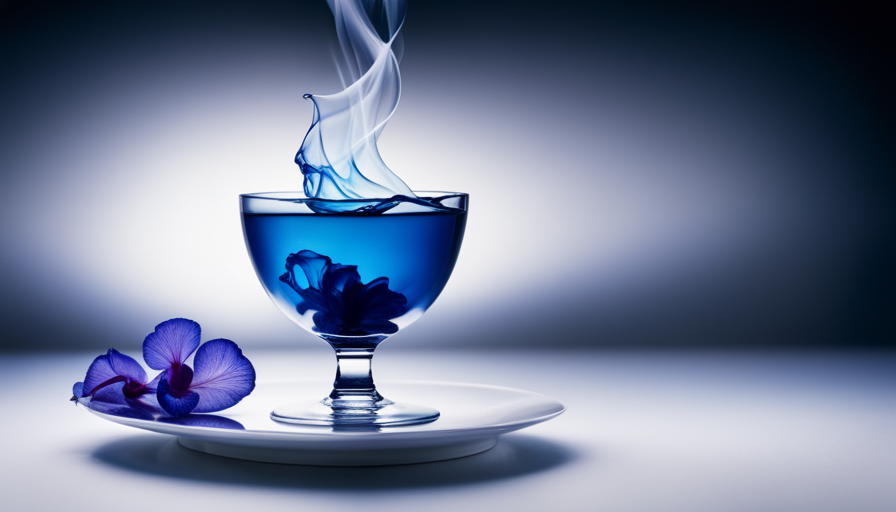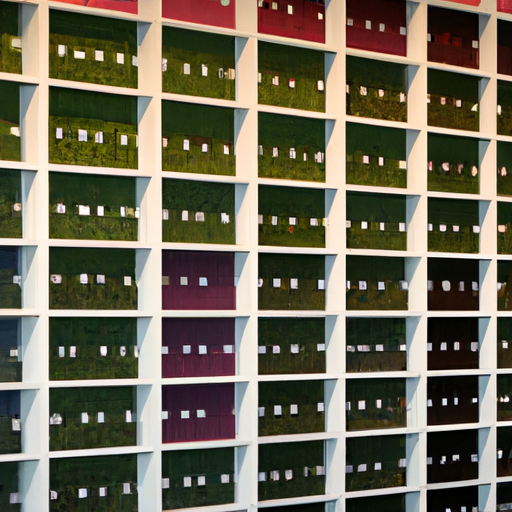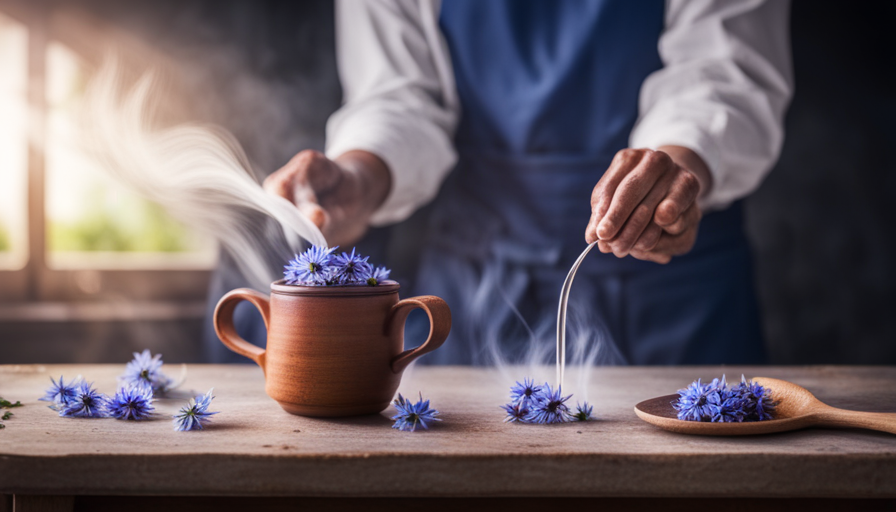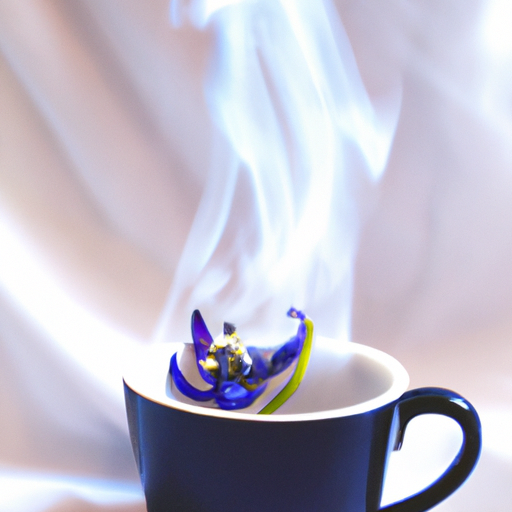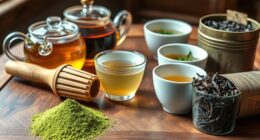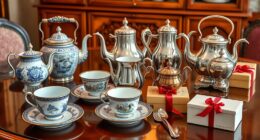Imagine this scenario: you are seated in a beautiful garden, enveloped by colorful blossoms. The sun is beaming down, and a soft breeze caresses your skin. As you drink your tea, you are transported to a place of complete contentment. This is the sensation that butterfly pea flower tea provides.
Butterfly pea flower tea, derived from the vibrant blue petals of the Clitoria ternatea plant, is a beverage that not only captivates with its mesmerizing color but also tantalizes the taste buds with its unique flavor profile. It’s like a symphony of sweet and earthy notes, with herbal and floral undertones dancing delicately on your palate.
This enchanting tea has a long history, originating in Southeast Asia and gaining popularity across the globe. Not only is it a delightful beverage, but it also boasts an array of health benefits.
From promoting relaxation to boosting brain function, butterfly pea flower tea has much to offer.
Whether you enjoy it on its own, or experiment with adding it to cocktails and mocktails, butterfly pea flower tea is sure to captivate your senses and leave you craving for more.
So, why not embark on a magical journey and discover the exquisite taste of butterfly pea flower tea for yourself?
Key Takeaways
- Butterfly pea flower tea has a unique flavor profile that is earthy and subtly sweet.
- The tea’s vibrant blue color adds to the overall experience and creates a sense of tranquility and relaxation.
- Butterfly pea flower tea can be enjoyed hot or cold and is versatile in culinary creations, including cocktails, desserts, and savory dishes.
- The tea pairs well with flavors like lemon, lime, ginger, and lemongrass, enhancing its taste and creating a more complex flavor profile.
Origins and History of Butterfly Pea Flower Tea
So, you’re probably wondering where this beautiful tea with its vibrant blue color comes from and how it ended up in your cup. Well, let me tell you the fascinating origins and history of butterfly pea flower tea!
Butterfly pea flower tea, also known as Clitoria ternatea tea, is derived from the petals of the butterfly pea flower, which is native to Southeast Asia. This exquisite tea has been enjoyed for centuries, with its origins dating back to ancient Ayurvedic practices in India.
The butterfly pea flower holds great cultural significance in many Asian countries, including Thailand, Malaysia, and Vietnam. In traditional Thai culture, butterfly pea flower tea is believed to have numerous health benefits, including improving eyesight, promoting healthy skin, and boosting brain function. It is also used as a natural food coloring agent, lending its vibrant blue hue to various dishes and beverages.
The cultural significance of butterfly pea flower tea extends beyond its medicinal properties. In Thailand, it is often served as a welcome drink to guests as a symbol of good luck and hospitality. The tea is also used in traditional ceremonies and celebrations, adding a touch of elegance and beauty to the occasion.
Now, let’s move on to the aroma of butterfly pea flower tea, which complements its captivating visual appeal.
The Aroma of Butterfly Pea Flower Tea
Delighting the senses, the aroma of this enchanting brew transports you to a fragrant oasis. As you bring the teacup to your lips, the first thing that captivates you is the visual appeal of butterfly pea flower tea. Its deep blue hue, reminiscent of a summer sky, is a sight to behold. The vibrant color is not only visually stunning but also adds to the overall experience of enjoying this tea.
In addition to its visual appeal, butterfly pea flower tea has calming effects that can be felt even before taking a sip. The delicate fragrance that wafts from the cup has a soothing quality, instantly putting you at ease. The aroma is floral and earthy, with subtle hints of sweetness.
-
The deep blue color of the tea creates a sense of tranquility and relaxation.
-
The floral aroma evokes a feeling of serenity and peace.
-
The earthy undertones add a grounding element to the overall experience.
With its visually captivating appearance and calming aroma, butterfly pea flower tea sets the stage for the flavor profile that awaits. As you take your first sip, the taste of this unique brew unfolds, revealing its intricate layers of flavor. [Transition to the subsequent section about ‘the flavor profile of butterfly pea flower tea’.]
The Flavor Profile of Butterfly Pea Flower Tea
Indulge in the enchanting flavor journey that awaits as you take a sip of this mesmerizing brew, where each sip unlocks a symphony of taste notes that dance on your palate like a harmonious melody. The flavor profile of butterfly pea flower tea is truly unique and captivating. Not only does it possess a delicate and floral taste, but it also boasts color-changing properties that add to its allure.
One of the most fascinating aspects of butterfly pea flower tea is its ability to change color. When brewed, the vibrant blue petals release a deep blue hue, but when combined with citrus or other acidic ingredients, the tea magically transforms into a stunning shade of purple. This color-changing phenomenon adds an element of surprise and visual appeal to the tea-drinking experience.
Beyond its stunning colors, butterfly pea flower tea holds cultural significance in Southeast Asia. It has been used for centuries in traditional Thai and Malaysian cuisines, and is often enjoyed as a refreshing beverage. Its vibrant blue color is believed to bring good luck and is often used in ceremonial and festive occasions.
As we delve further into the enchanting world of butterfly pea flower tea, we will discover its delightful sweet and earthy notes that make it truly irresistible.
Sweet and Earthy Notes in Butterfly Pea Flower Tea
Unveiling the hidden layers of complexity, butterfly pea flower tea reveals sweet and earthy notes that entice the senses with their subtle and alluring presence. This unique tea, derived from the vibrant blue petals of the butterfly pea flower, offers a flavor profile that’s both intriguing and delightful.
The sweetness of the tea is reminiscent of honey, with gentle hints of caramel and vanilla lingering on the palate. The earthiness, on the other hand, adds depth and richness to the overall taste, creating a harmonious balance.
Butterfly pea flower tea is not only known for its exquisite taste, but also for its versatility in various culinary creations. Its vibrant blue color makes it a popular ingredient in cocktails, desserts, and even savory dishes. From butterfly pea flower infused gin to butterfly pea flower ice cream, the possibilities are endless when it comes to incorporating this tea into recipes.
Furthermore, butterfly pea flower tea is also used as a natural dye. Its deep blue hue can be extracted and used to color various foods and beverages, providing a visually stunning and all-natural alternative to artificial food coloring.
Transitioning into the subsequent section about herbal and floral undertones in butterfly pea flower tea, it’s fascinating to explore the intricacies of this captivating beverage.
Herbal and Floral Undertones in Butterfly Pea Flower Tea
Discover the hidden nuances of butterfly pea flower tea as its herbal and floral undertones transport you to a realm of tranquility and serenity, where nature’s wisdom unfolds with every sip.
This enchanting herbal infusion, derived from the vibrant blue petals of the butterfly pea flower, offers a delicate and refreshing taste that’s truly unique. The tea’s herbal essence reminds you of fresh green tea, with a subtle earthiness that adds depth to its flavor profile.
As you take a sip, you’ll notice the gentle floral undertones that dance on your palate, leaving a delightful and lingering aftertaste.
Butterfly pea flower tea also has another remarkable quality—it serves as a natural dye. When steeped in hot water, the deep blue petals release their vibrant color, transforming the liquid into a mesmerizing azure hue. This visual spectacle adds to the overall sensory experience, making butterfly pea flower tea a feast for the eyes as well as the taste buds.
As you explore the possibilities of butterfly pea flower tea, you’ll find that it pairs harmoniously with a variety of flavors. From the citrusy notes of lemon and lime to the earthy tones of ginger and lemongrass, the tea’s versatility allows for endless pairing options.
So, venture forth and discover the perfect companions to accompany your journey through the world of butterfly pea flower tea.
Pairing Options for Butterfly Pea Flower Tea
With its versatile nature, butterfly pea flower tea can be perfectly complemented by a myriad of flavors, creating a harmonious symphony of taste sensations. When it comes to pairing options, this vibrant blue tea offers a unique twist to both sweet and savory dishes. The distinct herbal and floral undertones of butterfly pea flower tea make it an excellent choice for enhancing the flavors of a variety of foods.
For savory dishes, consider using butterfly pea flower tea as a natural food coloring agent or marinade. Its vibrant blue color can add a visually stunning touch to rice dishes, noodles, or sauces. Additionally, the earthy and subtly sweet taste of the tea can infuse into meats or vegetables, adding depth and complexity to your culinary creations.
If you’re looking for alternative uses for butterfly pea flower tea, try incorporating it into cocktails or mocktails. Its vibrant blue hue can make for visually appealing and refreshing beverages. Mix it with citrus flavors like lemon or lime for a tangy twist, or combine it with other herbal teas for a more complex flavor profile.
In the next section, we will explore the health benefits of butterfly pea flower tea and delve into its potential as a natural remedy.
Health Benefits of Butterfly Pea Flower Tea
Butterfly pea flower tea offers a bouquet of health benefits, acting as a soothing elixir for the body and mind. This vibrant blue tea isn’t just visually appealing but is also rich in antioxidants, which help protect the body against free radicals and reduce the risk of chronic diseases.
Additionally, it’s known to promote healthy digestion and alleviate constipation due to its natural laxative properties. The tea also has anti-inflammatory effects, which can help reduce inflammation in the body and potentially alleviate symptoms of conditions like arthritis.
Furthermore, butterfly pea flower tea is said to support brain health and improve cognitive function, thanks to its ability to enhance blood flow and oxygen supply to the brain.
While butterfly pea flower tea has numerous health benefits, it’s important to be aware of potential side effects. Some individuals may experience mild stomach discomfort or allergic reactions. It’s always recommended to consult with a healthcare professional before incorporating any new herbal tea into your routine.
In addition to its health benefits, butterfly pea flower tea can be enjoyed in various recipes. From colorful cocktails and mocktails to baked goods and smoothies, this versatile tea can add a unique touch to your culinary creations.
Transitioning into the subsequent section about brewing methods for butterfly pea flower tea, let’s explore the different ways to prepare this delightful beverage.
Brewing Methods for Butterfly Pea Flower Tea
Now that we’ve discussed the health benefits of butterfly pea flower tea, let’s move on to the brewing methods for this delightful beverage.
To make the perfect cup of butterfly pea flower tea, you’ll need a few key pieces of equipment. Firstly, you’ll need a kettle or pot to boil water, as this will be the base for your tea. Next, you’ll need a teapot or infuser to steep the dried butterfly pea flowers in hot water. This will allow the vibrant blue color and delicate flavors to infuse into the tea. Finally, you’ll need a strainer or filter to remove any remaining flower petals or debris before serving.
When it comes to the best time to drink butterfly pea flower tea, it really depends on your personal preference. Some people enjoy it in the morning as a refreshing and soothing way to start the day. Others prefer to sip on it in the afternoon as a calming and hydrating beverage. And some even enjoy it in the evening as a relaxing and naturally caffeine-free alternative to traditional tea or coffee.
Now that we’ve learned how to brew the perfect cup of butterfly pea flower tea and when to enjoy it, let’s explore how we can add this beautiful tea to cocktails and mocktails, taking our drinks to a whole new level.
Adding Butterfly Pea Flower Tea to Cocktails and Mocktails
To take your cocktail or mocktail game to the next level, why not experiment with the mesmerizing colors and delicate flavors of butterfly pea flower tea? Not only does this vibrant blue tea add a stunning visual element to your drinks, but it also brings a unique taste that’s both floral and earthy.
One way to incorporate butterfly pea flower tea into desserts is by using it as an ingredient in ice cream or sorbet. The tea infuses the frozen treat with its beautiful blue hue, creating a visually appealing and delicious dessert.
Another option is to make a butterfly pea flower tea syrup, which can be drizzled over cakes, pastries, or even pancakes for a burst of flavor and color.
When it comes to cocktails, the possibilities are endless. Experiment with different types of alcohol in butterfly pea flower tea cocktails to create your own signature drink. Vodka, gin, and rum all pair well with the delicate flavors of the tea. You can also add citrus fruits like lemon or lime to enhance the floral notes.
Incorporating butterfly pea flower tea into your cocktails and mocktails adds a unique touch that’ll impress your guests. Now that you’ve discovered the wonders of this tea in drinks, let’s explore other uses of butterfly pea flower tea in the next section.
Exploring Other Uses of Butterfly Pea Flower Tea
Indulging in the versatility of butterfly pea flower tea is a delightful adventure that unveils a world of endless possibilities and tasteful surprises. This vibrant blue tea isn’t just perfect for cocktails and mocktails, but it can also be used in desserts and skincare to add a touch of uniqueness and elegance.
When it comes to desserts, butterfly pea flower tea can be used as a natural food coloring agent. Its stunning blue hue can transform a simple cake or pastry into a visually stunning masterpiece. From blue velvet cupcakes to blueberry tarts, the possibilities are truly endless. Not only does it add a pop of color, but it also imparts a subtle earthy and floral flavor to the desserts, creating a delightful sensory experience.
In addition to desserts, butterfly pea flower tea has also found its way into skincare products. Due to its antioxidant properties, it’s believed to help combat signs of aging and promote healthier-looking skin. It can be used in facial masks, serums, and even bath products to provide a nourishing and revitalizing experience. The tea is known for its ability to soothe and calm the skin, making it a popular ingredient in natural skincare routines.
Overall, the versatility of butterfly pea flower tea extends beyond the realm of beverages. Its unique flavor and stunning blue color make it an exciting addition to desserts and skincare products, offering a whole new world of creativity and enjoyment.
Frequently Asked Questions
Can butterfly pea flower tea be consumed hot or cold?
Butterfly pea flower tea can be enjoyed both hot and cold, depending on personal preference. It offers numerous health benefits, such as being rich in antioxidants and having anti-inflammatory properties. To prepare it hot, steep dried butterfly pea flowers in hot water for a few minutes. For a refreshing iced version, steep the flowers in hot water, then let it cool and serve over ice.
It’s a versatile and delicious beverage that can be enjoyed in various ways.
How long does it take to brew butterfly pea flower tea?
Oh, the joy of waiting for butterfly pea flower tea to brew! It’s a true test of patience and anticipation. The steeping process is like a delicate dance, as I carefully pour hot water over the beautiful blue flowers and watch as they release their vibrant color.
It takes about 5-10 minutes for the tea to reach its full potential, infusing the water with a mesmerizing hue. Ah, the satisfaction of a perfectly brewed cup of butterfly pea flower tea!
Does butterfly pea flower tea contain caffeine?
Butterfly pea flower tea doesn’t contain caffeine, making it a great alternative to traditional caffeinated teas. This herbal tea is known for its vibrant blue color, which can change to purple when lemon or lime juice is added.
In addition to being caffeine-free, butterfly pea flower tea offers various benefits. It is rich in antioxidants and has anti-inflammatory properties. To make this tea, simply steep the dried butterfly pea flowers in hot water and enjoy its beautiful hue and health benefits.
Can butterfly pea flower tea be used as a natural food coloring?
Yes, butterfly pea flower tea can be used as a natural food coloring. It’s a vibrant blue color that can be extracted from the flowers. Unlike synthetic dyes, butterfly pea flower tea is a healthier alternative. It adds a beautiful blue hue to various dishes and beverages, such as smoothies, desserts, and cocktails. Its natural pigments aren’t only visually appealing but also provide antioxidants and other health benefits.
Are there any potential side effects or allergies associated with butterfly pea flower tea?
There are no known side effects or allergies associated with butterfly pea flower tea. However, it’s always important to consume any new food or drink in moderation. Butterfly pea flower tea is known for its potential health benefits, including antioxidant properties and promoting healthy skin.
To prepare the tea, steep a handful of dried butterfly pea flowers in hot water for about 5 minutes, strain, and enjoy hot or cold.
Conclusion
In conclusion, butterfly pea flower tea is a fascinating and versatile beverage with a unique taste profile. Its origins and history make it a cultural gem, while its aroma and flavor offer a delightful sensory experience.
With sweet and earthy notes complemented by herbal and floral undertones, this tea is a true delight for the taste buds. Not only is it delicious, but it also boasts numerous health benefits, such as improving digestion and boosting the immune system.
So why not give butterfly pea flower tea a try and experience its wonders for yourself? Fun fact: Did you know that butterfly pea flower tea is often used as a natural food coloring agent due to its vibrant blue color?

